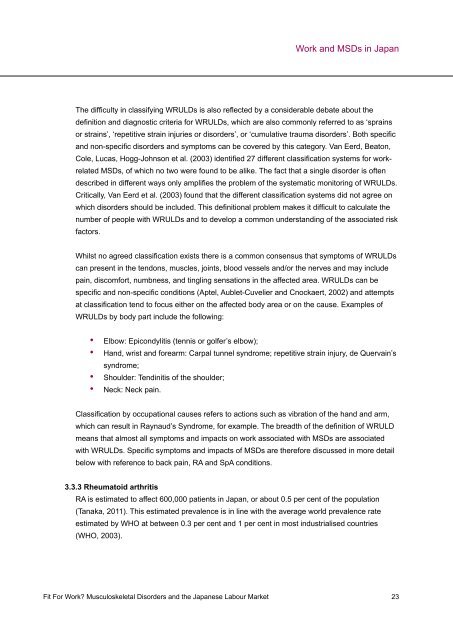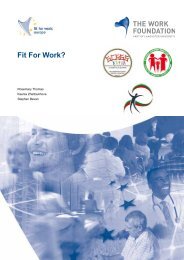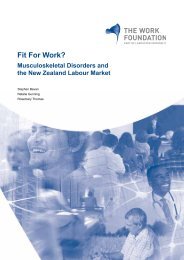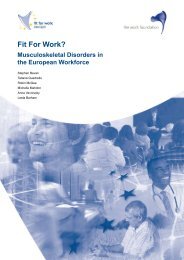English version - Fit for Work Europe
English version - Fit for Work Europe
English version - Fit for Work Europe
Create successful ePaper yourself
Turn your PDF publications into a flip-book with our unique Google optimized e-Paper software.
The difficulty in classifying WRULDs is also reflected by a considerable debate about the<br />
definition and diagnostic criteria <strong>for</strong> WRULDs, which are also commonly referred to as ‘sprains<br />
or strains’, ‘repetitive strain injuries or disorders’, or ‘cumulative trauma disorders’. Both specific<br />
and non-specific disorders and symptoms can be covered by this category. Van Eerd, Beaton,<br />
Cole, Lucas, Hogg-Johnson et al. (2003) identified 27 different classification systems <strong>for</strong> workrelated<br />
MSDs, of which no two were found to be alike. The fact that a single disorder is often<br />
described in different ways only amplifies the problem of the systematic monitoring of WRULDs.<br />
Critically, Van Eerd et al. (2003) found that the different classification systems did not agree on<br />
which disorders should be included. This definitional problem makes it difficult to calculate the<br />
number of people with WRULDs and to develop a common understanding of the associated risk<br />
factors.<br />
Whilst no agreed classification exists there is a common consensus that symptoms of WRULDs<br />
can present in the tendons, muscles, joints, blood vessels and/or the nerves and may include<br />
pain, discom<strong>for</strong>t, numbness, and tingling sensations in the affected area. WRULDs can be<br />
specific and non-specific conditions (Aptel, Aublet-Cuvelier and Cnockaert, 2002) and attempts<br />
at classification tend to focus either on the affected body area or on the cause. Examples of<br />
WRULDs by body part include the following:<br />
• Elbow: Epicondylitis (tennis or golfer’s elbow);<br />
• Hand, wrist and <strong>for</strong>earm: Carpal tunnel syndrome; repetitive strain injury, de Quervain’s<br />
syndrome;<br />
• Shoulder: Tendinitis of the shoulder;<br />
• Neck: Neck pain.<br />
Classification by occupational causes refers to actions such as vibration of the hand and arm,<br />
which can result in Raynaud’s Syndrome, <strong>for</strong> example. The breadth of the definition of WRULD<br />
means that almost all symptoms and impacts on work associated with MSDs are associated<br />
with WRULDs. Specific symptoms and impacts of MSDs are there<strong>for</strong>e discussed in more detail<br />
below with reference to back pain, RA and SpA conditions.<br />
3.3.3 Rheumatoid arthritis<br />
<strong>Work</strong> and MSDs in Japan<br />
RA is estimated to affect 600,000 patients in Japan, or about 0.5 per cent of the population<br />
(Tanaka, 2011). This estimated prevalence is in line with the average world prevalence rate<br />
estimated by WHO at between 0.3 per cent and 1 per cent in most industrialised countries<br />
(WHO, 2003).<br />
<strong>Fit</strong> For <strong>Work</strong>? Musculoskeletal Disorders and the Japanese Labour Market 23







